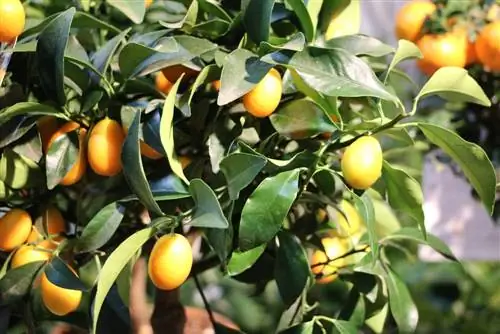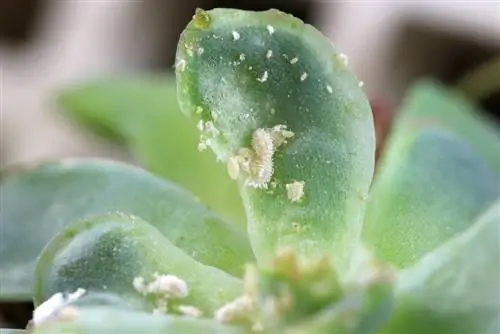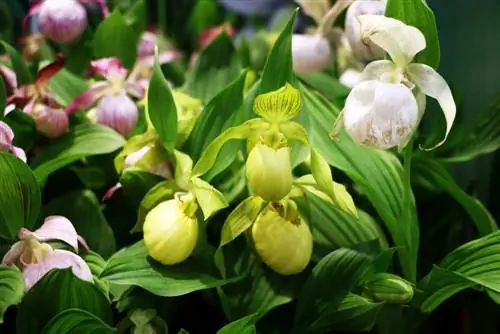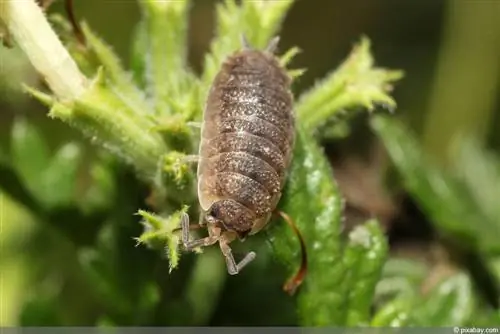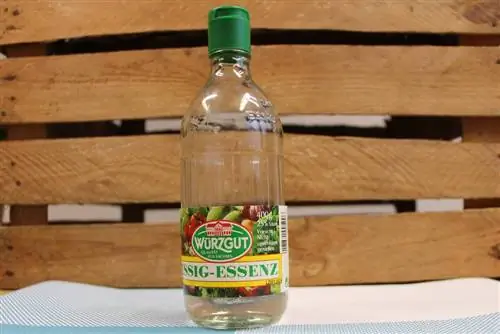- Author admin [email protected].
- Public 2023-12-17 03:39.
- Last modified 2025-06-01 06:48.
Make your own citrus fertilizer? That sounds more difficult than it is. Even in the case of specific deficiencies, home remedies can often help easily and very cost-effectively and provide the lemon plants with targeted care. Fertilizing citrus plants requires more than just using a suitable fertilizer - the timing should also be estimated precisely. The right knowledge about fertilizer, timing, deficiencies and needs of citrus trees can be found here. This means you can harvest a large harvest of fresh fruit even without a green thumb.
Citrus plants
Whether orange, lemon or kumquat - citrus plants in mini format, as trees or small shrubs are now even available in supermarkets and discount stores and are extremely popular. No wonder, because the plants are decorative and promise to deliver fresh fruit directly from their own cultivation. They produce harvests even in the smallest of spaces, because the citrus plants thrive in pots and therefore fit easily on the balcony, terrace or in a sunny hallway.
In addition, thanks to the pot culture, the plants can easily change places if the location was perhaps not quite optimal or if they have to be brought indoors to overwinter.
The small-format citrus plants offer many advantages. When it comes to fertilization, however, they require a little more than plants grown outdoors because they simply lack the supply of nutrients from the environment. However, there are numerous home remedies and simple fertilizers that are very easy to make yourself. But it's not just these that matter.
Fertilization time
That sounds simple, but it largely depends on the temperature and the incidence of light. If the lemon plants are warm and bright from early spring to late autumn, they grow faster and have a higher nutrient requirement. In a rather cool and shady location, the demand can be comparatively low even in midsummer.
As a rule of thumb:
Citrus plants are only fertilized if they are growing.
So careful observation is required here. For new shoots and leaves, citrus plant fertilizer should be used at least between April and August. If necessary, the fertilization phase can last longer. Only when growth stops does the administration of additional nutrients have to be stopped.
Tip:
As long as watering is regular and plentiful, fertilizer should also be applied.
Fertilization intervals
These, like the times, should be made dependent on current needs. Watering is a good indication of this, as fluid consumption indicates both growth and the resulting need.
Watering should always take place when approximately the upper third or at most the upper half of the substrate has dried. This can be determined either by using a moisture meter or by feeling directly in the substrate. Citrus plants are watered in such a way that the substrate can be completely soaked but the roots are not exposed to waterlogging.
In summer, experience shows that watering can be done about every week or every other week. Fertilization can also be carried out at these intervals between spring and autumn. Of course, the intervals between doses also depend on which fertilizer is used.
Nutrient requirements
Citrus plants mainly need nitrogen, potassium and phosphorus.
The ideal complete fertilizer for Mediterranean plants contains these nutrients in a ratio of 4:3:1 to 3:2:1. So three to four parts nitrogen, two to three parts potassium and one part phosphorus.
The nutrient requirements are also supplemented by trace elements:
- Iron
- Zinc
- Magnesium
- Boron
- Copper
- Manganese
- Molybdenum
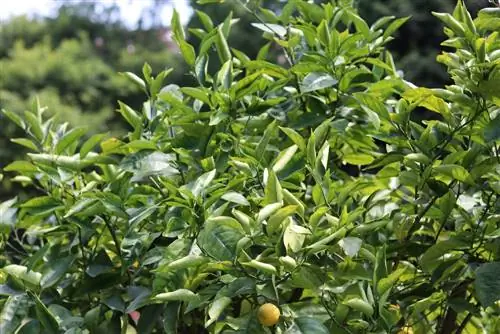
It is almost impossible to achieve this exact composition when making your own citrus fertilizer with home remedies - and in general with organic fertilizers. If you want to make it easy for yourself and be on the safe side, you should choose a ready-made mineral fertilizer or a special citrus fertilizer from the trade.
However, if there is enough time to experiment, home-made fertilizer can be a practical and inexpensive alternative. Especially because it can be adapted more individually to current needs.
Recognizing deficiencies
Lemons, oranges, kumquats and the like often suffer from the following four deficiencies:
- Iron deficiency
- Magnesium deficiency
- Nitrogen deficiency
- Zinc deficiency
- Potassium deficiency
- Phosphorus deficiency
An iron deficiency can be recognized by the fact that the leaves turn yellowish to brownish, but the leaf veins remain green. Yellowing also occurs when there is a magnesium deficiency, but here it starts from the tip of the leaf. When there is a nitrogen deficiency, the leaves turn an even and complete yellow color. If there is a zinc deficiency, yellow spots can be found between the leaf veins.
If there is a lack of potassium, necrosis occurs on the edges of the leaves, which means they turn brown and die. A phosphorus deficiency is manifested by a reddish discoloration of the leaves.
In order to recognize a defect, you have to look closely. It is then important to select an appropriate citrus fertilizer. For prevention, it also makes sense to provide comprehensive care.
Home remedies and simple measures as citrus fertilizer
Container cultivation poses a problem when fertilizing citrus plants. The abundance of soil organisms is limited, making it difficult for organic materials and compounds to decompose. A possible solution to this is to allow organic material to decompose in advance - i.e. to produce compost. However, it is also possible to use it in a liquid decoction form as a fertilizer.
Especially making a brew is ideal if the targeted production of fine compost is not possible. In addition, some tricks can also be used to care for the Mediterranean plants.
Repotting and soil change
An annual repotting at the beginning of budding or changing the soil saves fertilizing for around six weeks. If the soil is also enriched with nutrient-rich material, fertilization can be avoided for even longer.
Suitable as a base is ready-made citrus soil from the trade or a home-made mixture of seven parts high-quality plant soil with two parts drainage material, such as gravel or gravel, and one part quartz sand.
Leaves and peels
In nature, the citrus fruits' own leaves and peels would fertilize the plants. The leaves and fruits fall down and rot on the ground, causing the nutrients to go back into the substrate. This is not possible to this extent in a bucket, but falling leaves and dried peels can be used wonderfully as fertilizer.
It is best to chop up the material, dry it and either mix it directly into the substrate when changing the soil or add it to the bottom of the pot in spring and work it superficially into the soil. It is also possible to use vegetable scraps to make fine compost.
Tip:
The peels should be cut or grated as small as possible before drying. This simplifies subsequent application and reduces the risk of mold formation.
Coffee
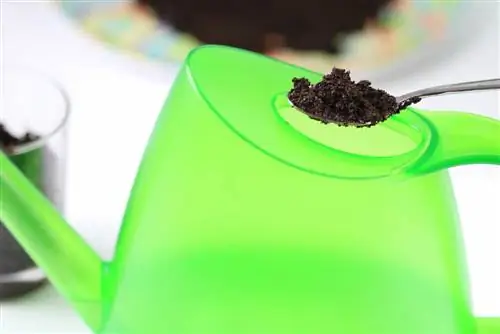
Coffee grounds are the ideal citrus fertilizer. It contains nitrogen, phosphorus and potassium, is found in almost every household and is easy to use. It also has a slightly acidifying effect on the substrate, which is an advantage for citrus plants as they appreciate a slightly acidic pH value.
To make the natural fertilizer, the coffee grounds are dried and added directly to the soil or added to the irrigation water. It can be used once a month.
Comfrey
Just like nettle, comfrey is also suitable as a citrus fertilizer. The preparations are also the same.
Blood Meal
Unusual but known and valued as a fertilizer for a long time, blood meal is particularly rich in iron. It also contains some trace elements that can help citrus plants grow better.
It is recommended if there are signs of iron deficiency and is simple. The blood meal is added directly to the soil and lightly incorporated or dissolved in the irrigation water. A dose of one to three teaspoons per plant can be given weekly until the deficiency symptoms disappear.
If the fruits are intended for consumption, attention should of course be paid to the origin and he alth safety of the blood.
Tip:
Instead of blood meal, fresh blood from the butcher or frozen blood from the BARF range for dogs and cats can also be used as citrus plant fertilizer.
Aquarium water
If you own an aquarium or pond, you have a natural, practical and gentle way of fertilizing directly in your living room or garden - because the water can be used directly for watering during the growth phase. The preparation is limited to taking water. The effort required for this fertilizer for citrus plants is correspondingly low.
Vegetable and potato water
When potatoes or other vegetables are cooked, many of the minerals and trace elements are washed out and are then contained in the cooking water. That's why it's a shame to throw this away. Instead, it can be used for watering and fertilizing at the same time.
Tea
Tea, like coffee, contains the desired nutrients that are important for the he althy growth of lemon plants - but in smaller quantities. For this reason, tea and tea grounds may also be used frequently. Depending on the size of the plant, one to three teaspoons of tea grounds can be worked superficially into the soil per fertilizer application or a cup of tea can be mixed into the irrigation water. The tea grounds work longer, but the nutrients from the tea infusion are available more quickly and do not affect the substrate.
If you want to fertilize less often, you should use tea grounds or tea leaves or the contents of tea bags, but only use them once or twice a month. With diluted tea, however, you can water weekly during the fertilization season.
Tip:
Green tea and black tea are optimal.
Algae and algae limestone
Rich in minerals, both algae and algae lime are suitable for fertilization. Especially with algae lime, it should be noted that it has an alkaline effect and influences the substrate accordingly. It can therefore be used specifically to balance the pH value if it becomes too acidic.
Otherwise, however, it should be used sparingly. The situation is similar with algae or algae or kelp flour. A small amount added to the substrate or mixed in when changing the soil provides plenty of vitamins and minerals, which is why it should not be used too often. Experience has shown that in strong growth phases, one dose per month is sufficient.
Stinging Nettle
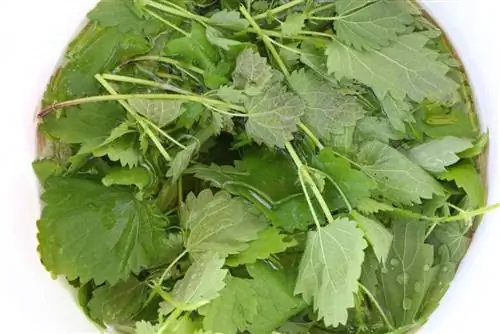
Decried as a painful weed, the nettle has many advantages to offer and is suitable both as a fertilizer and to combat some pests. It contains iron and other minerals and trace elements such as potassium, calcium, phosphorus and nitrogen.
To fertilize the lemon plants, proceed as follows:
- The nettles are finely chopped or cut and placed in a preserving jar. The plant parts should be packed as tightly as possible into the glass.
- The glass is filled with water and placed in a warm, sunny place.
- After 12 to 48 hours, the water is drained and used to water the citrus plants. The application can be done once a month.
If you're in a hurry, you can just leave the brew in the sun for eight hours and then let it simmer with all the plant parts for about half an hour. After cooling, it can be diluted in equal parts with water and used for watering.
Conclusion
If you want to make your own citrus fertilizer, you can find many suitable ingredients in your own kitchen or in the form of nettles and comfrey outdoors. Complex mixtures and preparations are usually not necessary. However, precise checks of the plants and possible signs of deficiency are essential.

